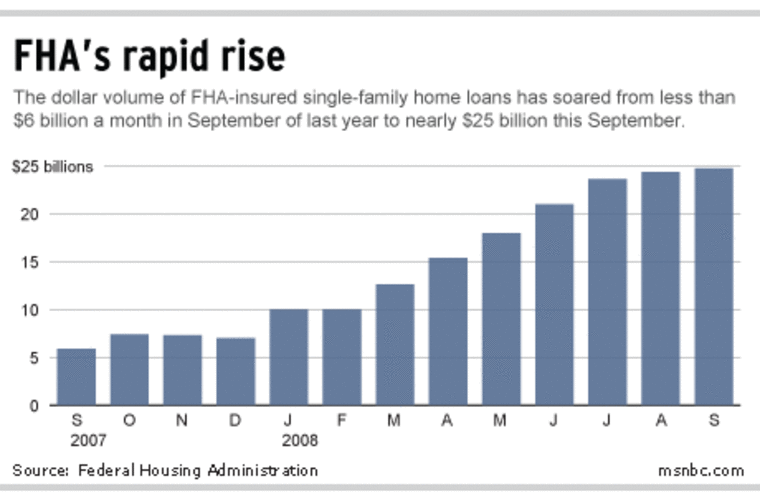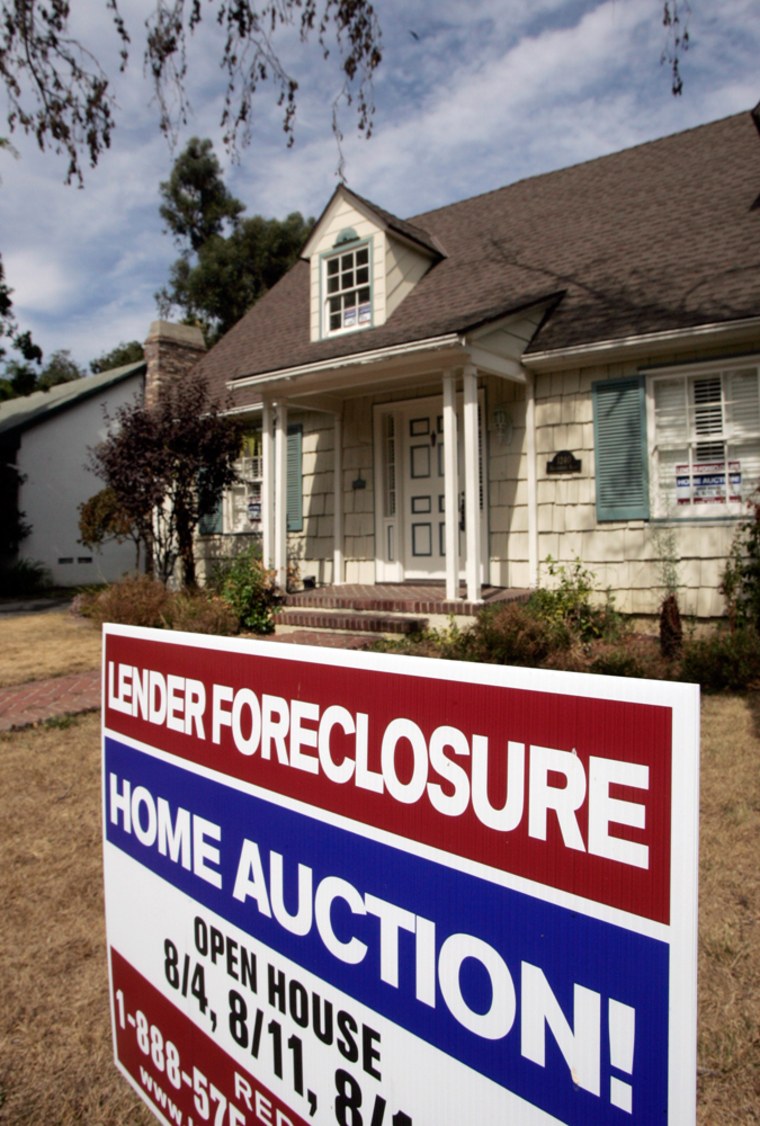The collapse of the subprime mortgage industry and its fallout on conventional lenders has led to such a boom in business at the Federal Housing Administration that the agency is now insuring nearly one in five new residential mortgages, helping prop up sales in some of the nation’s battered real estate markets.
The FHA’s surge in business, which includes many loans to high-risk borrowers who put just 3 percent down in markets where real estate prices are in decline, raises questions about a potential hit to taxpayers in the future.
The agency, however, says there’s no cause for concern.
“FHA is doing very well and we expect that to continue,” Meg Burns, FHA’s director of single-family program development, told msnbc.com.
But some observers say the booming market for FHA-insured loans could lead to problems down the road.
“Values are dropping and nobody’s got a safety net and that’s what worries me about FHA,” said Scott Evans of Atlanta, whose Family Mortgage is one of the top five mortgage brokers in Georgia. “We’re taking on a lot of risk as taxpayers that used to be in the private sector.”
While the agency’s standards are open to debate, there is no doubt that demand for its services is soaring.
Among the highlights in statistics provided by Burns and FHA spokesman Lemar Wooley:
- FHA’s single-family market share has skyrocketed to 17 percent, a nearly six-fold increase in the last two years.
- The volume of FHA-insured single-family mortgages, for both purchases and refinances, has risen from an average of $4.9 billion a month in fiscal 2007 to over $24 billion in the last quarter — a pace that threatens to surpass the agency’s congressional authorization of $180 billion in new business for the year.
- FHA currently insures 4.4 million single-family mortgages — or about one in every 10 U.S. home mortgages, with a total unpaid balance of $474 billion.
Created to help 'first-time and minority homebuyers'
Created by Congress in 1934, the FHA’s mission is to provide mortgage insurance to private lenders to encourage the flow of mortgage money to “households not served or underserved by the private sector, most notably first-time and minority homebuyers,” according to FHA’s annual report.

FHA borrowers typically have less money – often, none – for down payments and poorer credit than conventional borrowers. While most FHA loans require down payments of at least 3 percent, the entire amount can be a gift from a friend, a relative or other sources as long as it isn’t from the seller. TheFHA does not set minimum credit scores for borrowers and allows them to have blemishes in their credit files that would prevent them from obtaining conventional loans. The agency’s rules also let borrowers qualify with the help of co-signers – friends, parents or other relatives – who will not be living in the mortgaged home.
But the FHA is not a subsidy program. Borrowers pay for the insurance through up-front premiums — currently 1.75 percent of the loan, or $1,750 per $100,000 — and insurance fees on their loans — generally 0.5 percent a year on the unpaid balance, or $500 on a $100,000 balance. The premiums fund a reserve pool, now at $28 billion, as well as the agency’s operating costs.
“We don’t rely on taxpayer dollars,” Burns said.
In the go-go days of the subprime industry, with many lenders making far riskier loans than they are now, the FHA process was seen by many real estate professionals as overly expensive for borrowers and fraught with red tape. Consequently the agency’s market share fell from 11 percent in the mid-1990s to just 3 percent in 2006.
Rebound began two years ago
FHA’s current ascendancy began that year, when it streamlined its appraisal process and eased its often fussy standards on property conditions, which kept many sellers from accepting offers from FHA buyers. At the same time, FHA-insured loan limits were increasing, eventually topping out at $729,500 in many high-cost areas of the country, although that will decrease to $625,000 on Jan. 1.
When subprime loans dried up, FHA quickly became a good option for many borrowers, including some with good credit and larger down payments. Across the nation, lenders and mortgage brokers that sell FHA products ramped up that part of their business.
In the Detroit suburb of Birmingham, Mich., for example, Shore Mortgage recently announced that it was hiring 40 new employees to deal with a surge in FHA activity, a 10 percent increase in its overall staffing. Much of Shore’s new FHA business is coming from refinancing, President Robert Rahal said in a release.
FHA-insured loans “absolutely” have made a big impact in the Seattle-area real estate market, Keith Tibbles, president of Cobalt Mortgage, told msnbc.com in an interview. Cobalt, Washington state’s largest privately held mortgage company and its No. 3 FHA shop after Wells Fargo and Countrywide, has seen FHA-insured loans go from 2.5 percent of its business in 2006 to about 30 percent currently.
In the Seattle area, where the median home price is about $400,000, a buyer can get an FHA-insured mortgage of up to $567,500 with 3 percent down. “That’s a really low down (payment) for that kind of loan size,” Tibbles said. Until recently, even buyers with good credit and substantial down payments, who wouldn’t need mortgage insurance on a conventional loan, were finding interest rates on FHA loans attractive enough in some price ranges to offset the FHA insurance payments.
Is the phenomenal surge in FHA-insured loans a cause for taxpayer concern? Some observers of U.S. mortgage markets think so, especially if continuing declines in real estate prices make it more practical for buyers who see their equity wiped out to walk away rather than pay off their loans.
‘It probably is going to be quite costly’
“I’m not sure I’d call it a subprime debacle but there’s certainly the potential for increased losses,” said Bert Ely, an Alexandria, Va.,-based consultant on financial institutions and monetary policy and one of the first experts to publicly predict the full scope of the savings and loan crisis of the 1980s and ‘90s. “I haven’t tried to put any numbers on it, but it probably is going to be quite costly.”
Evans, the Georgia mortgage broker, said FHA loans aren’t so attractive in the Atlanta market, where the median home price of about $200,000 is much lower than some other markets. “The only people that fit into the FHA camp that I come across have less than a 660 credit score,” said Evans. “If you’re in our industry, you hear frequently … that FHA is the new subprime.
“We went from being able to do anything for anybody to now, that if your credit score is less than 660 you’re almost forced to do an FHA loan. … It tells you that the surge in FHA lending is for people who have less than stellar credit. … I think that all we’re doing is transferring the problem to the FHA.”
Evans’ company does not sell FHA loans. But even Tibbles of Cobalt Mortgage, which is now deriving a third of its business from FHA products, says the notion of an FHA default crisis is “a valid concern.”
“It would be naïve to say there’s not potential for losses there,” he said. “But (the) history with FHA is that it’s been very successful as a self-funding program. … It’s about controlling risk.”
Projections seen as cutting risk
That’s exactly right, said FHA’s Burns. “As a mortgage insurance company, we have set our underwriting standards in a way that we are able to predict what we think the default and claim rates will be,” she said. “We have to run our business in a break-even manner, so we have to run those projections every year.”
This year, Burns noted, FHA raised its up-front insurance premium from 1.5 percent to 1.75 percent. Some borrowers — those who are delinquent on an existing mortgage and refinance through FHA, for instance — pay 3 percent. “This is a borrower with a riskier profile,” she said. “The premium should be a little bit higher.”
With FHA’s reserve account now at $28 billion, “We’re in pretty solid shape,” Burns said. Asked whether a sudden surge in defaults on FHA-backed loans could create a crisis that would empty the reserve account and force taxpayers to mount another financial rescue, Burns said, “This sounds obnoxious, but there’s just really no way that would happen.”
In addition to the reserve fund standing at nearly 6 percent of FHA’s current single-family mortgage obligations, defaulted mortgages are not 100 percent losses, she said. When an FHA-insured loan is foreclosed, FHA pays the balance owed to the lender, reclaims the property and sells it. So the ultimate cost of the default to FHA is the difference between the balance and costs of foreclosure and what the property brings when sold.
And Wooley, the FHA spokesman, said the agency’s loss-mitigation efforts enable most borrowers who fall behind on their payments to remain in their homes. “Of 156,867 homeowners in serious default in 2008, only 55,700 of those actually went to foreclosure,” he wrote in an e-mail.
In the latest data available from the Mortgage Bankers Association, the FHA foreclosure start rate of 0.95 percent is about 50 percent higher than the 0.61 percent rate for all prime loans, but far below the 4.26 rate for subprime loans.
Burns said that because FHA had such a small market share during the heyday of subprime lending, “We are not suffering like everyone else. We don’t have the losses on our books that other people are seeing.”
“We actually came into this crisis on pretty solid ground that very much protects the FHA fund, and the business we see going forward is very, very nice business.”
